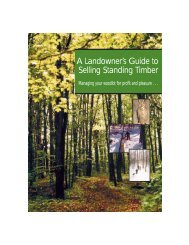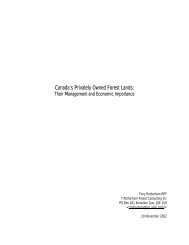A land manager's guide to conserving habitat for forest birds in ...
A land manager's guide to conserving habitat for forest birds in ...
A land manager's guide to conserving habitat for forest birds in ...
You also want an ePaper? Increase the reach of your titles
YUMPU automatically turns print PDFs into web optimized ePapers that Google loves.
Male Scarlet Tananger — Pho<strong>to</strong>: Jeff Nadler<br />
Skunk cabbage <strong>in</strong> swamp<br />
Pho<strong>to</strong>: Robert McCaw<br />
PREFACE<br />
Forests are important <strong>for</strong> our communities, socially, economically, and ecologically.<br />
They ma<strong>in</strong>ta<strong>in</strong> clean air and water, provide <strong>habitat</strong> <strong>for</strong> thousands of plants and animals,<br />
present recreational opportunities, provide <strong>in</strong>come, and contribute <strong>to</strong> human health<br />
and general well be<strong>in</strong>g. In southern Ontario, the amount of <strong>for</strong>est has been<br />
dramatically reduced from what it was be<strong>for</strong>e European settlement <strong>in</strong> the early<br />
n<strong>in</strong>eteenth century. Today, ensur<strong>in</strong>g the quality and ecological <strong>in</strong>tegrity of those<br />
rema<strong>in</strong><strong>in</strong>g wood<strong>land</strong>s is vital. Healthy <strong>for</strong>ests cont<strong>in</strong>ue <strong>to</strong> provide natural goods and<br />
services while ma<strong>in</strong>ta<strong>in</strong><strong>in</strong>g biodiversity. Individual <strong>land</strong>owners are stewards over much<br />
of these rema<strong>in</strong><strong>in</strong>g wood<strong>land</strong>s. Though many recognize the value of ensur<strong>in</strong>g long-term<br />
health and ecological function, how <strong>to</strong> accomplish this is often unclear. For example,<br />
<strong>land</strong>owners of <strong>for</strong>ests with economically valuable mature trees may be <strong>in</strong>terested <strong>in</strong><br />
harvest<strong>in</strong>g, but are uncerta<strong>in</strong> of the associated effects on wildlife and overall <strong>for</strong>est<br />
health. Some may wish <strong>to</strong> identify the most appropriate harvest<strong>in</strong>g method <strong>to</strong> meet<br />
their management goals. Others may wish <strong>to</strong> employ management techniques that can<br />
benefit wildlife, or preserve wildlife areas. F<strong>in</strong>ally, some <strong>land</strong>owners may want <strong>to</strong> know<br />
how their woodlot contributes <strong>to</strong> biodiversity conservation at a larger, <strong>land</strong>scape scale.<br />
This <strong>guide</strong> is designed <strong>to</strong> address these questions and provide <strong>land</strong>owners with<br />
<strong>in</strong><strong>for</strong>mation on the <strong>habitat</strong> requirements of local <strong>for</strong>est bird species, and the effects of<br />
different <strong>land</strong> management strategies on their populations. A clever woodlot owner has<br />
the awareness and knowledge <strong>to</strong> effectively manage his or her <strong>for</strong>ests <strong>for</strong> profit and still<br />
preserve diverse and healthy <strong>for</strong>ests <strong>for</strong> future generations.<br />
Although the <strong>for</strong>ests of southern Ontario provide <strong>habitat</strong> <strong>for</strong> a variety of organisms<br />
<strong>in</strong>clud<strong>in</strong>g plants, <strong>in</strong>vertebrates, reptiles, amphibians, and small mammals (some of<br />
which may be sensitive <strong>to</strong> disturbances associated with timber harvest<strong>in</strong>g), we have<br />
chosen <strong>to</strong> focus this discussion on <strong>for</strong>est <strong>birds</strong>. Birds are one of the most visible wildlife<br />
groups, compris<strong>in</strong>g hundreds of different species of extraord<strong>in</strong>ary variety from<br />
humm<strong>in</strong>g<strong>birds</strong> <strong>to</strong> eagles. Each species is unique <strong>in</strong> appearance, habits, and <strong>habitat</strong>.<br />
Some occur <strong>in</strong> huge numbers while others are sparse; some are sedentary, preferr<strong>in</strong>g <strong>to</strong><br />
spend their entire lives with<strong>in</strong> a few hectares, while others<br />
undertake extraord<strong>in</strong>ary annual migrations. Birds are an<br />
obvious and diverse component of our <strong>for</strong>est ecosystem and<br />
among one of the most valued and appreciated components<br />
of our biodiversity.<br />
Land <strong>birds</strong> <strong>in</strong> particular, provide billions of dollars <strong>in</strong><br />
ecosystem services (natural processes that benefit humans) as<br />
consumers of pest <strong>in</strong>sects, poll<strong>in</strong>a<strong>to</strong>rs, dispersers, and<br />
preda<strong>to</strong>rs of native seeds. They help ma<strong>in</strong>ta<strong>in</strong> the same<br />
ecosystems that support human life. Many <strong>for</strong>est <strong>birds</strong> are<br />
sensitive <strong>to</strong> the structure, composition, and configuration of<br />
<strong>for</strong>ests and are good <strong>in</strong>dica<strong>to</strong>rs of general <strong>for</strong>est health.<br />
Because <strong>birds</strong> are valuable <strong>to</strong> humans <strong>in</strong> a multitude of ways,<br />
current decl<strong>in</strong>es <strong>in</strong> some populations are cause <strong>for</strong> concern.<br />
As wildlife <strong>habitat</strong> is directly affected by how humans use<br />
the <strong>land</strong>, we all have a responsibility <strong>for</strong> not simply<br />
prevent<strong>in</strong>g ext<strong>in</strong>ctions, but <strong>in</strong> ma<strong>in</strong>ta<strong>in</strong><strong>in</strong>g healthy<br />
populations of species that are still common.<br />
Preface<br />
1

















